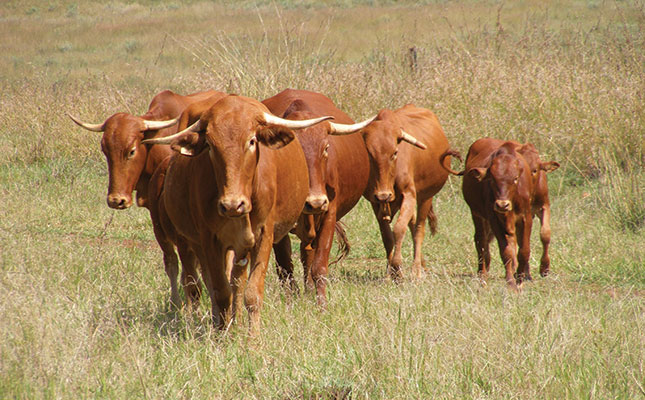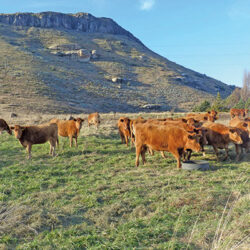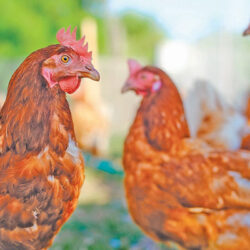Beef cattle production is often regarded as a lesser part of diversification on a crop production farm, with the animals beingkept on marginal soils, grazing and grain stover. However, given the current economic realities and challenges, it can no longer be considered a low-input and low-income concern.
“The cattle component, while it has the potential to add considerable value to any diversified farming operation, irrespective of the size thereof, can be a highly lucrative source of income through effective management and the implementation of basic precision farming practices,” says Hennie Snyman, an animal scientist from Parys in the Free State.
“Commercial beef cattle production has developed beyond a low-input concern that is kept on the fringes of the main business, and should be managed as such.”
Animals and the environment
According to Snyman, the implementation of precision beef cattle farming principles does not have to be an intricate affair. It calls for common sense, good planning and keeping track of the interaction between the animals and their environment.
“Without effective planning, no business will survive in the long run. My motto is that while it is good to do the right thing at the right time, it is more important to do the right thing correctly at the right time.
“This markedly cuts down on any margins of error in favour of sustainability and profitability. Without the necessary information and data, beef cattle producers will be very hard-pressed to make informed and valid decisions,” he says.
Snyman says an environment conducive to optimal production is non-negotiable.
Moreover, the environment does not only include the natural ‘setting’, but also includes factors such as breeding seasons, animal health protocols, nutrition and supplemental feeding, as well as parasite control.
“Genetics obviously also play a role in the selection of beef cattle, but sound environmental management is of far greater importance. No animal can and will perform optimally in a poorly managed situation. It’s vital that the production environment is first developed vertically. Only then can producers start to think about horizontal development of a beef production concern. One of the biggest problems I’ve come across is that producers start developing horizontally before the vertical environment has reached maturity,” he explains.
For instance, breeders will be well advised to create a year-long management programme based on the prevailing climatic conditions in the area where they farm. Using data such as the dates when the rainy season usually begins, the general duration of the season and the distribution of the rain will make it possible to effectively make informed decisions on management plans for the full year. This includes matters such as grazing rotation, reproduction and herd health.
Respect grazing
Snyman says one of the first lessons a cattle producer must learn is that he or she needs to respect the grazing available on his or her farm as the most valuable resource in the business.
As such, the veld’s carrying capacity, determined by the number of animals the veld can support at a given time, should be respected by farmers adhering to the appropriate stocking rates, which refers to the number of animal units, or mature livestock units, on the veld at a given time.
The condition and the conservation of grazing form an integral part of precision farming management, he adds.
Snyman says this demands that landowners and managers regularly inspect the amount, the type and the composition of the grazing available to their cattle herds.
“It is of no value for a breeder to merely observe veld condition from a distance. The veld must be inspected regularly in detail and preferably from above.
“Producers need to actually walk the veld to ascertain the condition from top to bottom. The apparent condition of the veld can often be very confusing if only inspected from a bakkie.
“A lack of information in terms of the condition of the available grazing could result in serious stocking rate miscalculations, to the detriment of both animals and the environment,” he explains.
Rotational grazing
An effective grazing rotation system is an essential part of sustainable beef cattle production. Rotational grazing works on the basic principle of graze and rest. Once a camp is grazed, it should be allowed to undergo a complete rest period so that the veld can be rejuvenated for the next grazing period.
This generally leads to higher grazing yields and, combined with the correct stocking rate, results in more grass being utilised, which means more grass converted into beef for the farmer’s profit.
Another benefit of regular veld inspections is that it allows the breeder the opportunity to keep track of the cattle’s rumen health and to ascertain whether the ration composition is effective.
Marked changes in manure can be an indication of problems pertaining to rations.
Snyman says that assessing an animal’s nutrition can be as simple as examining its manure.
Evaluating manure can provide an early indication of dietary problems, such as too much or too little fibre, excess or insufficient degradable protein, or excess mineral consumption.
Very liquid or runny manure can indicate ruminal acidosis, irritation of the hindgut or even disease, while thick manure with a thick consistency signals good rumen health and a well-digested ration.
Very dry and firm manure with clearly defined segments is a sign of poor-quality grazing that contains low-quality fibre in excess.
Record-keeping
“Record-keeping is vital to fully determine and utilise the potential of grazing. Records need to be kept of the number of animals in a specific camp, the duration of the grazing period, as well as the type of animals kept in the camp.
“After a few seasons, the camp’s production potential will become clear, making it possible to draw up a dry-matter budget for the next season.
“In times of drought, data gathered this way will make it much easier for farmers to take precautionary measures and remove animals timeously from the veld, while they are still in a good condition.
“This will go a long way to avoid crisis sales and ensuing low prices,” says Snyman.
A producer’s annual management programme should be developed in such as way as to keep the animals healthy and well fed, says Snyman.
For example, the programme should be designed in such a way that it provides for timeous vaccinations against prevailing diseases. This will, to a large extent, prevent producers falling prey to vaccine shortages.
Snyman emphasises the importance of the synchronisation of the animals’ nutrient demand with the nutrient supply of the veld in order to keep production rates as high as possible. Not only does this contribute markedly to high reproduction rates, but it also lessens the dependence on supplemental licks and nutrients.
“This means animals must be grouped according to nutrient demands, and every group’s supplemental feed provision must be designed accordingly.
“Because of their varying nutrient requirements, it simply does not make economic sense to group young animals with older animals. The dietary needs of heifers, for instance, in terms of protein and energy, differ vastly from that of cows,” he says.
Nutrition and condition
Nutrition forms the backbone of a livestock production concern. Shortcomings in this regard will invariably have an eventual impact on profitability. Reproduction and growth are two of the factors that will be negatively affected by poor and ineffective nutrition, resulting in less money in the producer’s pocket.
“I have found that producers who succeed to sustainably maintain high reproduction rates reinvest about 20% of the income generated through breeding animals in animal feed and supplements,” says Snyman.
According to him, the main objective of a beef cattle production concern is to annually produce the optimum numbers of calves. While weight and other hereditary traits play an important role in the production of weaners, the condition of the dams play the most important part, he says.
To ensure breeding animals remain in top condition, a dynamic and vital grazing system is therefore indispensable. On a scale of 0 to 5, the dams’ condition should never be lower than 2 and should be between 3 and 3,5 at the beginning of the breeding season, says Snyman.
“Farmers can be assured of success if they make use of precision farming methods. To measure is to know. By improving the effectiveness of the business, inputs are reduced and outputs are increased.”
Email Hennie Snyman at hennie@paradigm-sa.co.za.




